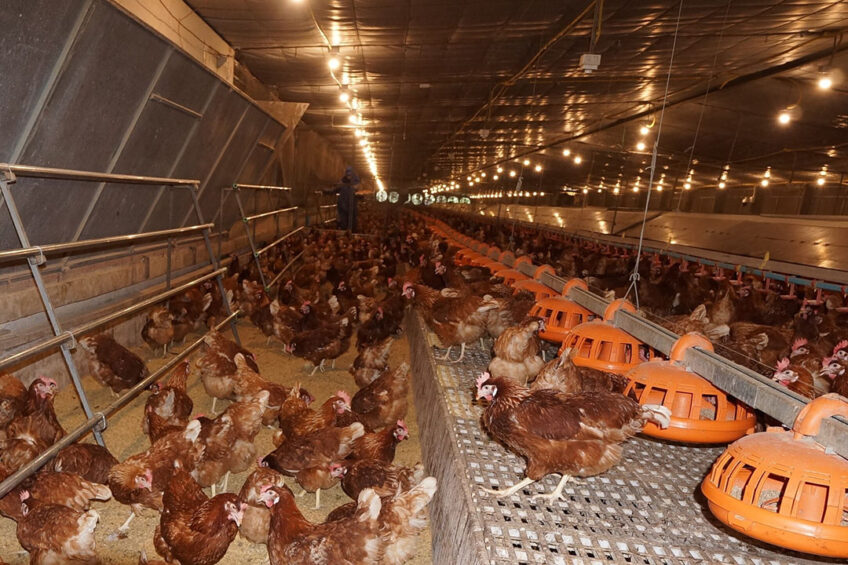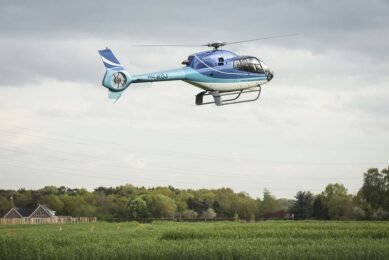CP Foods revs up cage-free production

Charoen Pokphand Foods (CPF) is set to rev up cage-free egg production to meet the increasing demand from the food service industry and consumers concerned about animal welfare.
Senior VP of CPF, Somkid Wannalukkhee, comments on receiving the first ever Thai cage-free certification for its showcase Wang Somboon farm.
During the first few months of 2021, the Thailand Department of Livestock started enforcing the cage-free farming standard and invited eligible farms to sign up for certification.
Thailand’s layer industry striving to meet international standards
CPF’s Wang Somboon farm was the first to apply as it had been designed as a showcase free-range farm since its inception in 2018. Subsequent inspections went smoothly and certification was awarded. Somkid explains: “The cage-free standard certification represents a major milestone for Wang Somboon farm and Thailand’s layer hen industry which is striving to meet international standards. The certification also reflects CP Foods’ commitment to strengthening food safety and animal welfare standards in Thailand’s agricultural sector to increase the competitiveness of Thai products and support sustainable consumption.”
SE Asian hospitality sector moves toward cage-free eggs
A total of 15 hotel chains from 10 Southeast Asian countries came together recently to look at building animal welfare into their corporate identity. Quite inspiring for the egg sector, too. Read more…
‘Five freedoms’
CPF’s cage-free production strategy was designed to meet the future needs of the food industry. CP Foods’ Wang Somboon farm has operated cage-free production since 2018 using the EU standard farming model. The laying hens are raised based on the internationally recognised ‘Five freedoms’: consisting of freedom from hunger and thirst, freedom from discomfort, freedom from pain, injury and disease, freedom from fear and distress, and freedom to express animal instincts and behaviour. As a result the hens are happy, healthy and antibiotic-free throughout their lives.

International food and hotel groups going cage-free
International food companies and hotels, for example, Nestlé, Unilever, Hilton and others, have set 2025 as their deadline to begin sourcing cage-free eggs for their supply chains. In Thailand, UK retailer, Tesco, will sell only cage-free eggs by 2030. “The quality of CPF cage-free eggs is identical to premium imported Japanese eggs that are odour-free and can be eaten raw. But our eggs are fresher and the price is remarkably cheaper,” says Somkid.
Satisfying demand for cage-free eggs
Apart from complying with rigorous cage-free standards and animal welfare guidelines, another major obstacle is providing enough volume to ensure customers have access to an uninterrupted supply. This requires so much patience and capital that only a few producers have been up to the task, says Somkid.
First cage-free barn opened in Vietnam
Vietnam joins other Southeast Asian countries in the movement to promote cage-free eggs with the opening of the country’s first commercial cage-free barn. Read more…
At present, CPF produces around 10 million cage-free eggs a year but could boost that figure to 35 million based on the current capacity of Wang Somboon farm in Saraburi, 100km northeast of Bangkok. The farm, originally built in 2002 as a broiler breeder farm, covers 22.8 hectares. Later, in 2018, it was renovated to accommodate cage-free layer farming.
SIngle-age production system
In cage-free production, layer and pullet houses are thoroughly cleaned and disinfected before rearing starts. At Wang Somboon, a single-age production system is used. The layer chicks come from the same source and are moved to production houses at 16 weeks of age. The pullets familiarise themselves with the new house for about 2 weeks before laying starts. Currently, there are 7 layer houses (12×120m) with 70,000 birds in total. At present, this creates a sufficient supply of eggs of all sizes to supply customers year-round.
Infrared beak treatments
There is also a pullet-growing house using a floor-rearing system with evaporative cooling, deep litter, roosts and other enrichments. Day-old chicks receive infrared beak treatments to limit injuries from feather pecking and the risk of cannibalism. The beak tip will drop off at 5-7 days of age. The treatment does not cause injury to the chicks compared with the conventional cauterising method. They are reared in closed houses to prevent insecticide contamination and intestinal worms.

Salmonella-free
The breeding stock is tested to ensure that they are free of salmonella. Management aims to minimise salmonella risks due to genetics, age and stress induced by overcrowding. A pest control programme keeps out wild birds and rodents. The parent stock hatchery is fully automated to keep the operating crew to a minimum, as well as prevent human error and contamination.
Interview: Different ways to farm eggs
Canadian Jon Krahn was selected for the Young Egg Leader programme of the International Egg Commission. One year into the programme he shares his experience with Poultry World. Read more…
Pulse sensors have replaced candling to sort out infertile eggs on day 18, when the eggs are moved from setters to hatchers. The birds are generally healthier. Feed consumption is increased in line with the extra freedom of movement, and a culling age of 75 weeks is observed, as recommended by Thailand’s Egg Board.
Cost of quality
Cage-free production comes at a cost because 8 times fewer birds can be housed in the same space than with convention battery cage production. This is a major obstacle because most customers are far from happy to pay even twice the price of conventional eggs, says Somkid. Rearing density is 5-7 birds/m2 which is less than the recommended 9 birds/m2. Floor space is 1,100 cm2/bird. Feeding space for pan feeders is 4.3 cm/bird and there are 1.25 nipple drinkers for every 10 birds. The birds are fed ad lib. Rice husks are used as litter material. Perches are installed 20cm from the wall, with 30cm between perches. The perching space is 15 cm/bird.
Nests for the layers
There is a common nesting area. A 100 metre-long group nest runs from the front to the rear of the house. Various nest types are being tested to find out which work best. Feeders and drinkers are placed above the slats to encourage the birds to jump up and use the nests. The goal is to make the nest area the most attractive spot for the hens to lay eggs in order to keep floor eggs to less than 1% of the total.

About 1.4m2 of nest space is available for every 120 hens, again a figure more generous than the recommended EU standard of 1 m2/120 birds. Each stockman looks after 10,000 birds compared to 200,000 under a typical caged production system. Staff regularly inspect the flock a few times a day to remove dead birds.
CPF’s cage-free eggs
CPF uses Hyline Brown due to its all-around egg quality, exemplary Haugh unit which is above 90%, and superior eggshell quality. The eggs are sorted on site primarily to eliminate those with misshapen, dirty and defective eggshells. They are subsequently sent via refrigerated trucks to CPF’s joint grading facility in Nakorn Nayok, 90km away from the farm, for cleaning, UV disinfection and grading. The grading machine can automatically detect blood spots and cracks. The quality control (QC) team at the grading facility takes eggshell swabs every day to test for the presence of salmonella. They also monitor eggshell thickness, eggshell strength, Haugh unit, egg weight, yolk colour and more.
Exports make up 3% of output
CPF exports around 3% of its total output to stabililise domestic prices and some 12% of the total production is set aside for processed eggs. At present, the company produces around 6 million eggs a day. In the table egg market, CPF is penetrating further into modern trade outlets and other niches, such as food service operators in the hospitality sector. It also offers small packages that better meet the needs of today’s smaller families.
Increasing capacity
CPF is always ready to raise capacity in line with market demand. It recently launched cage-free eggs in 4-egg packages at 7-11 stores in the Bangkok area, and now supplies top-notch restaurants, such as Jay Fai restaurants, DonDonDonki and Mo-Mo Paradise. The eggs are also available at Makro wholesaler. New customers are being developed for processed eggs, such as tofu makers and bakeries. CPF supplies 10,000 tonnes of liquid eggs per annum to buyers in the domestic market.
Sustainable farming
CPF recently started to renovate its layer operations where the main thrust of the new investment is to create good relations with neighbouring communities. All CPF farms now have dust and ammonia traps behind the exhaust fans to minimise odours and environmental disruption. It is also pursuing a zero waste policy with major investments in biogas reactors that use layer manure as a fuel. It has also improved manure handling to minimise ammonia content so that it does not disrupt methanogenesis microbes.
Cage-free eggs: US food companies under pressure
Several major US food companies have been exposed for failing to meet their public commitments to source 100% cage-free eggs from their egg supply chains by the end of last year. Read more…
New techniques have enabled CPF to generate 3 times the methane yield of conventional layer-manure based fermentation. Thailand began capturing biogas 2 decades ago using mainly pig manure. Although layer biogas has always been seen as slower and less efficient, Somkid noted that new production methods are closing the efficiency gap.
Author:
Apisit Buranakanonda
Join 31,000+ subscribers
Subscribe to our newsletter to stay updated about all the need-to-know content in the poultry sector, three times a week. Beheer
Beheer








 WP Admin
WP Admin  Bewerk bericht
Bewerk bericht